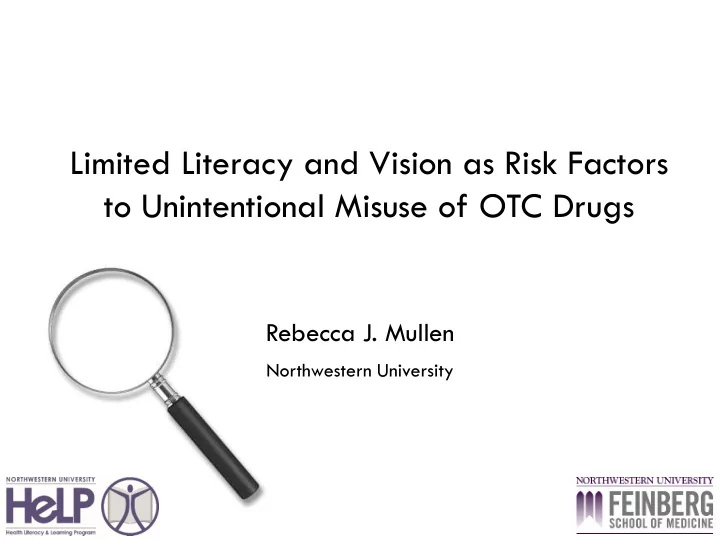

Limited Literacy and Vision as Risk Factors to Unintentional Misuse of OTC Drugs Rebecca J. Mullen Northwestern University
Acknowledgments Northwestern University Louisiana State University Michael Wolf, PhD MPH Laura Curtis, MS Terry Davis, PhD Rachel O’Conor , MPH University of Pennsylvania Emory University Marina Serper, MD Ruth Parker, MD Sponsored by an unrestricted research grant from McNeil Consumer Healthcare
Background Misuse of OTC drug products prevalent, often unintentional 1 Label instructions typically only means to inform patients Misunderstanding of label information root cause of errors Low health literacy strong risk factor Primary focus of FDA improvement efforts to date 1 Wolf et al. Risk of unintentional overdose with non-prescription acetaminophen products. JGIM. 2012;27:1587-1593.
Information Access Problematic packaging Limited real estate Minimal white space Small and variable font Poses 2 challenges Ability to see content Ability to read content Consumers of all literacy levels struggle to read labels
Visual Acuity as a HL Prerequisite Label must first be seen to be understood Evidence of HL associations, but none on visual acuity except impairment What are the relationships of both with OTC comprehension?
Objective To determine if visual acuity is associated with risk of OTC medication errors among a sample of functionally independent primary care adults
Methods Design: Cross-sectional, observational Subjects: 500 primary care patients, 1) 18-80 years old; 2) English speaking; 3) no severe cognitive, hearing or visual impairment Sites: 1 academic and 1 community GIM clinic each in Chicago and Atlanta (N = 4 clinics) Outcome: Functional understanding of 1) dosing instructions and 2) concomitant use
Visual Acuity Assessed via Snellen eye chart Severe impairment excluded (≥20/200 ) Remaining dichotomized into 2 groups: Normal vision (20/20-20/25) Low vision (20/30-20/100)
Functional Understanding Dosing Task Exceed max daily dose (4000mg/day) Improper Dosing Too many pills/dose Too many doses/day Improper Spacing Doses too close together
Functional Understanding Concomitant Use Task Taking 2 acetaminophen products at the same time when contraindicated Varied by brand, # of ingredients, indication + Base Product Secondary Product
Sample Characteristics Mean age: 49 years 63% female 57% African American 39% HS or less 35% <$20,000 39% limited HL 19% heavy APAP use (>2 times/week) 54% low vision Older, AA, lower income, less education, heavier APAP users, limited HL (50% vs. 25%)
Results – Dosing Task Generic Single Ingredient 30 25 20 15 % Normal Vision Low Vision 10 All p’s <0.001 5 0 Any Error Exceeds Max Improper Improper Dose Dosing Spacing *patients may have made more than one of these errors
Results – Concomitant Use Brand Single Ingredient (Pain) 40 35 30 25 20 % Normal Vision 15 Low Vision 10 5 All p’s <0.001 0 Generic Single Brand Brand Brand Ingredient Combination Combination Combination (Pain) (Sleep) (Pain) (Cold & Cough)
Model C 1 Model A Model B Dosing Error Visual Acuity Normal Vision -- -- Low Vision 1.77 (1.33-2.34)** 1.67 (1.25-2.21)** Health Literacy Adequate -- -- Limited 1.84 (1.34-2.52)** 1.71 (1.25-2.35)* Concomitant Use Error Visual Acuity Normal Vision -- -- Low Vision 1.62 (1.15-2.27)* 1.42 (1.10-2.00)* Health Literacy Adequate -- -- Limited 4.35 (2.94-6.43)** 4.14 (2.80-6.12)** controlling for: race/ethnicity, age, APAP use *<0.05 **<0.001 1 interaction of VA and HL NS
Model C 1 Model A Model B Dosing Error Visual Acuity Normal Vision -- -- Low Vision 1.77 (1.33-2.34)** 1.67 (1.25-2.21)** Health Literacy Adequate -- -- Limited 1.84 (1.34-2.52)** 1.71 (1.25-2.35)* Concomitant Use Error Visual Acuity Normal Vision -- -- Low Vision 1.62 (1.15-2.27)* 1.42 (1.10-2.00)* Health Literacy Adequate -- -- Limited 4.35 (2.94-6.43)** 4.14 (2.80-6.12)** controlling for: race/ethnicity, age, APAP use *<0.05 **<0.001 1 interaction of VA and HL NS
Model C 1 Model A Model B Dosing Error Visual Acuity Normal Vision -- -- Low Vision 1.77 (1.33-2.34)** 1.67 (1.25-2.21)** Health Literacy Adequate -- -- Limited 1.84 (1.34-2.52)** 1.71 (1.25-2.35)* Concomitant Use Error Visual Acuity Normal Vision -- -- Low Vision 1.62 (1.15-2.27)* 1.42 (1.10-2.00)* Health Literacy Adequate -- -- Limited 4.35 (2.94-6.43)** 4.14 (2.80-6.12)** controlling for: race/ethnicity, age, APAP use *<0.05 **<0.001 1 interaction of VA and HL NS
Model C 1 Model A Model B Dosing Error Visual Acuity Normal Vision -- -- Low Vision 1.77 (1.33-2.34)** 1.67 (1.25-2.21)** Health Literacy Adequate -- -- Limited 1.84 (1.34-2.52)** 1.71 (1.25-2.35)* Concomitant Use Error Visual Acuity Normal Vision -- -- Low Vision 1.62 (1.15-2.27)* 1.42 (1.10-2.00)* Health Literacy Adequate -- -- Limited 4.35 (2.94-6.43)** 4.14 (2.80-6.12)** controlling for: race/ethnicity, age, APAP use *<0.05 **<0.001 1 interaction of VA and HL NS
Conclusions Over half our sample had low vision Misuse of OTC products is common, independently impacted by visual acuity and health literacy skills Mild visual deficits capable of impacting safe use
Limitations Cross-sectional Hypothetical scenarios Limited to OTC acetaminophen products Did not assess for use of corrective lenses
Implications Increase screening by clinicians Updated prescriptions, corrective lenses Direct federal and industry efforts towards appropriate packaging changes Limit content Larger font size Increased white space
Thank You! Contact Information Rebecca Mullen, BS Doctoral Student Division of General Internal Medicine Northwestern University 750 N. Lakeshore Drive, 10 th Floor Chicago, IL 60611 312.503.3276 r-mullen@northwestern.edu
Recommend
More recommend